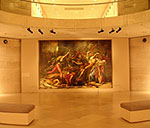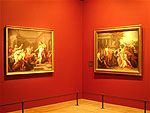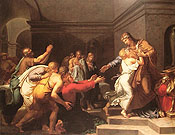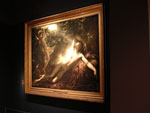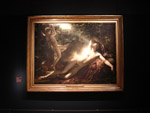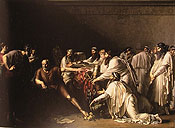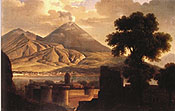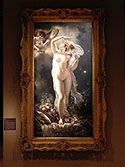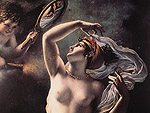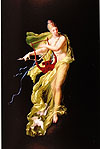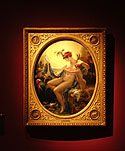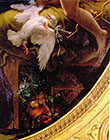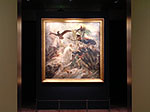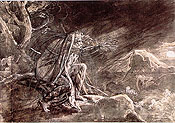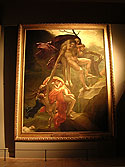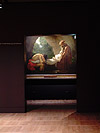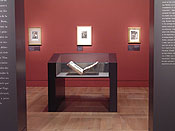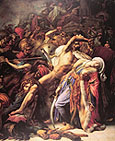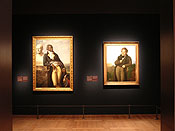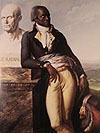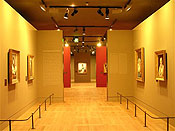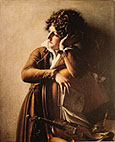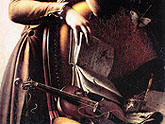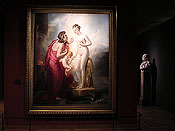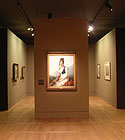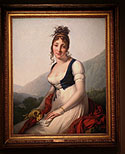| Photos courtesy of the author with the kind assistance of Céline Dauvergne. |
|
 |
Girodet (1767-1824)
Musée du Louvre, Paris, 22 September 2005-2 January 2006
The Art Institute of Chicago, 11 February 2006-30 April 2006
The Metropolitan Museum of Art, 22 May 2006-27 August 2006
Musée des Beaux-Arts, Montreal, 12 October 2006-21 January 2007
Girodet (1767-1824)
Sylvain Bellenger
Paris: Editions Gallimard / Musée du Louvre Edition, 2005
495 pp; 175 b/w figures and 300 color illustrations; index
49 € (hard cover)
ISBN 2-35031-038-8
|
 |
|
|
|
|
|
|
The art of the brilliant French maverick Anne Louis Girodet-Trioson (1767-1824) was first presented to the modern public almost forty years ago, in a legendary exhibition held at the Musée des Beaux-Arts in Montargis, the painter's birthplace 100 kilometers south of Paris. For the occasion the Montargis museum was completely emptied, and almost the entire Girodet holdings of the Louvre transferred and installed there. Major loans were secured, and in the end the exhibition included fifty paintings, fifty drawings and numerous prints, illustrated books and documents. A handy catalogue was published, and there were lengthy exhibition reviews in the Art Bulletin and the Burlington Magazine. Held the same year as the Ingres exhibition in Montauban (1967), the Girodet retrospective proved to be an important event of that golden age of early nineteenth-century French painting exhibits, which culminated in 1974 with the international, traveling exhibition David to Delacroix. |
|
|
|
|
|
|
|
After the success of the Girodet exhibition, the Musée des Beaux-Arts in Montargis was renamed the Musée Girodet. In 1983 an exhibition of Girodet drawings was held there, and a few years later in 1989, Sylvain Bellenger, the director of the Musée Girodet at the time, organized an exhibition of Girodet and Ossianism. Since the 1989 exhibition it has been the driving ambition of Sylvain Bellenger to mount a major retrospective of Girodet's art. Fifteen years later his goal has finally been realized: Girodet opened at the Louvre in September 2005 and will travel on to Chicago, New York and Montreal in the course of the next year and a half. The wait has been well worth it, especially for those of us unable to see the 1967 retrospective—the Girodet exhibition is a triumph (fig. 1). |
|
|
|
|
|
|
|
|
As the Louvre retrospective amply demonstrates, Girodet was the most creatively and unpredictably subversive of all of David's students. Even before he had fully mastered David's reforms, he began to reject the tenets of David's sober rational program, and explore the possibilities of an art that was more imaginative, poetic and above all idiosyncratic. Girodet entered David's atelier at the age of seventeen in 1784. The following year he painted The Death of Camilla, an exemplary student demonstration of Davidian artistic and moral principles. In the history paintings that immediately follow, however, there are already hints of rebellion, in the form of subtle, pictorial innovations that undermine the aesthetic rigor and stoic heroism of David's reformatory classical style. In the first room of the Louvre exhibition, the visitor can study Girodet's earliest attempts to liberate himself from the Davidian straitjacket. Here one finds Girodet's Prix de Rome of 1789, Joseph Recognized by his Brothers (figs. 2 and 3), along with two earlier history paintings of 1787 and 1788 respectively: another Old Testament scene, Nebuchadnezzar Orders the Execution of the Sons of Zedekiah, and a scene from early Roman history, The Assassination of Tatius, King of the Sabines. In these three paintings, one is struck by the delicacy of Girodet's color; he has renounced David's somber earth colors in favor of more recherché tints—iridescent lavender, rose, and cream—all brightened by a more evenly diffused lighting. Enlarging his search for greater artistic refinement, Girodet has also replaced David's simply folded, hanging mantles with elegant, flowing draperies. There are compositional and spatial transformations as well. Girodet has collapsed David's geometrically ordered stage sets, and arranged his actors along single shallow planes, with a marked emphasis on linear grace and a complicated surface design of rhythmically interlocked human forms. Meanwhile, Girodet's narrative has become more urgently dramatic, the gestures and movement of his figures more pressing, and their expressions more intense than in his classically restrained Camilla of 1785. Yet the overall impression of these history paintings remains one of preciosity, and even Girodet's dynamic passages of violence and brutality are curiously elevated to a more rarefied world of art and artifice. |
|
|
|
|
|
|
|
|
As a recipient of the 1789 Prix de Rome, Girodet left for the French Academy in Rome in the spring of 1790. Once arrived, he began almost immediately to work on The Sleep of Endymion (figs. 4 and 5), the painting that marks in many respects the completion of his first phase of pictorial experimentation, and stands as his true declaration of independence from David. Surprisingly, Girodet's earlier history paintings do little to prepare us for either the inventiveness of Endymion, or the ingeniousness of the poetic conceit that is the primary source of the picture's striking originality. Instead of appearing at her beloved's side wearing a human aspect, Girodet's Diana/Luna manifests herself as a pale, silvery moonbeam that enters the bucolic scene through branches carefully parted by an obliging Cupid, and tenderly caresses the graceful form and soft flesh of the sleeping Endymion. Correggio's Jupiter and Io comes to mind, where Zeus, having metamorphosed into a cloud, descends to make love to the ecstatic nymph Io. The two paintings share a related search for the most extreme refinement of erotic sensuality. Regardless of his sources, Girodet's softly sensuous ideal of male beauty, his oblique other-worldly light and his arbitrary treatment of nature are all far removed from the ruddy muscular heroes, the incisive theatrical lighting and the austere realism associated with David's revolutionary art. Even before Endymion was completed Girodet wrote: "I have not yet told M. David what I intend to send to the Academy. In the meantime, I will write to him before the exhibition, for I prefer that he learn it from me. I am attempting to distance myself from his genre as much as possible…." (p. 213). Indeed Girodet has taken David's proposition with its rational, objective handling of moralizing antique themes and turned it on its end, willfully transforming the model into a fanciful vehicle for subjective poetic expression. Some writers on Girodet consider The Sleep of Endymion the first masterpiece of French romantic painting. This may well be true. The Endymion generally hangs upstairs in the great nineteenth-century French painting gallery in the Louvre, but the picture benefits immensely from having been re-hung in its own spotlighted darkened room in the Louvre's temporary exhibition gallery. Not only is the painting's unsightly degraded bitumen all but invisible, but the new installation is more conducive to the private contemplation the picture demands. In the exhibition the Endymion has the look and feel of a highly wrought object of art, appropriately displayed in a black velvet box. |
|
|
|
|
|
|
|
|
Still in Rome, and very soon after completing Endymion, Girodet was at work on a new history painting, Hippocrates Refusing the Gifts of Artaxerxes (fig. 6). The subject is a patriotic one: the King of Persia's emissaries, laden with gold and gifts, fail to persuade the celebrated Greek physician to come to the rescue of their plague-ravaged states. The picture was painted for Dr. Trioson, Girodet's close friend, tutor and future adoptive father. Although Girodet's Hippocrates does develop some of the tendencies found in his earlier history paintings, he does not occupy himself in his new composition with further evolving or mastering a single heretical style. Instead, Girodet seems determined here to break new ground, and undertake yet another experimental effort to sabotage the canons of David's severe program. In his Hippocrates Girodet devotes exceptional, even obsessive attention to the archaeological accuracy of the painting's architectural décor, furnishings and props, as well as that of the exotic costumes, coiffures and even the beards of his Persian ambassadors. Girodet's concern with detailed historical reconstruction is complemented by an equally keen interest in elaborating a wide variety of human expression. Each one of the emissaries surrounding Hippocrates has a distinctly different psychological response to the physician's adamant refusal to aid their king and country. The envoys' charged expressions, that far exceed the noble restraint of David's stoic actors, range from anger and astonishment to grief and resignation. Working together, Girodet's novel pictorial priorities lend a literal, anecdotal quality to his new history painting, and the Hippocrates uncannily anticipates the entertaining and histrionic academic paintings of the mid-nineteenth century neo-Greeks. |
|
|
|
|
|
|
|
|
In January 1793, Girodet narrowly escaped a violent attack on the French Academy that had been provoked by the French Revolutionary Army's Italian campaign. Fearing for his life, he fled Rome for Naples, where he found himself liberated from the constraints of the Academy, and determined to pursue a long-standing enthusiasm for the art of landscape painting. Writing from Naples in March 1793 Girodet announced: "This spring and summer . . . my project is to travel through the environs of Naples, and stay there long enough to extract from this countryside everything of interest that it offers for art. It was in the environs of Rome, that I was going to devote myself this year to the study of landscape, a universal genre of painting to which all others are subordinate" (p. 233). At the sale of Girodet's atelier after his death, there were twenty-four painted landscapes and over a hundred landscape drawings. Only five of Girodet's landscape paintings have since been identified: three are in the Musée Magnin in Dijon, and two in the Louvre exhibition, one from a private collection and the other from the Musée Girodet.1 All five demonstrate Girodet's acute sensitivity to light; his View of Vesuvius (fig. 7), delicately illuminated by an early morning light that plays over the pale green slopes of the volcano, is the finest of the lot. Girodet drew extensively out of doors in nature, and at least one of his landscapes in the Musée Magnin, the impressive Gulf of Sorrento, is evidence that Girodet subscribed to his older contemporary Pierre-Henri de Valenciennes' program of executing oil sketches in the open air, to capture the momentary effects of light, shadow and atmosphere associated with different times of day and changing weather. While the two landscapes in the exhibition have a more composed studio quality, the Magnin sketch displays the freshness and unpretentiousness of the plein-air studies painted by Valenciennes and his followers in the Italian countryside during the 1780s and 90s. Unfortunately, Girodet did not follow up his interest in landscape after his return to France, but when more of his Italian paintings, and especially his oil sketches are identified, Girodet's brief, but intense experience with the art of landscape may well no longer be considered a minor chapter in his career. |
|
|
|
|
|
|
|
|
Girodet returned to Directoire Paris in 1795 after a five-year absence. He took quarters in the Louvre, and began his struggle to obtain recognition and success in a radically changed French society. Girodet's first commission came through the architect Charles Percier, a friend and colleague of Girodet from the French Academy in Rome, for a panel to decorate the salon of a Parisian hotel particulier designed by Percier for the finance minister Benoît Gaudin. For the subject of his large decorative panel (fig. 8) Girodet chose the myth of Danaë from Ovid's Metamorphoses. The beautiful Danaë has been confined to a tower by her father Acrisius, who has been warned by an oracle that his daughter will one day give birth to his slayer. But Zeus, outsmarting Acrisius, descends to Danaë one night as a shower of gold and she bears him a son, Perseus. Girodet's new commission was a further occasion for him to demonstrate his gift for poetic fantasy and sophisticated erotic sensuality. Girodet's Danaë is reminiscent of Endymion, which had enjoyed considerable success at the Salon of 1793. In both panels Girodet has imaginatively modified his classical literary sources. In his Danaë, Girodet's Jupiter has become a more gallant seducer than in the original Greek myth; he descends to Danaë not as a degrading downpour of gold coins, but rather as a gentle shower of precious jewels and perfumed flowers. And instead of reclining as she does in most prototypes, Danaë stands on her bed, nude, under a starry sky, as jewels magically attach themselves around her neck, arms, wrists and fingers (fig. 9). Quantities of dainty, painstakingly-described flowers—attesting to Girodet's lifelong interest in botany—adorn her hair and bed. Enraptured, Danaë gazes upward to admire herself in a mirror held up by a cupid, who points a torch toward her heart with his other hand. The Danaë has belonged to the Leipzig Museum since the mid-nineteenth century and did not travel to the 1967 retrospective. Nor for that matter did the next works shown in the Louvre exhibition: four decorative allegorical paintings of the seasons, commissioned by Percier and Fontaine to ornament a small, inlaid, wood paneled cabinet of their design for Charles IV of Spain, in the Royal Casa del Labrador at Aranjuez. The Four Seasons are closely related stylistically to the Danaë panel. They all share qualities of cool grace, linear sinuosity and a hard, enameled look of painted porcelain. Not since the school of Fontainebleau has French painting witnessed such a precious, arbitrary manner. Girodet's Summer (fig. 10) is a little masterpiece. Floating on a deep blue-black ground, the figure of Summer is clothed in a billowing, diaphanous, chartreuse-colored drapery, and a tightly woven headdress of meticulously painted flowers. A garland of miniature flowers hangs around her neck, and stretches across a lyre that she is playing with one hand. In her other hand she holds Cupid's arrow, while a pair of butterflies hovering behind the strings of the lyre, and a pair of doves partially enveloped by drapery, court under the spell of the music. |
|
|
|
|
|
|
|
|
Girodet returned to the theme of Danaë in his next picture, but before considering this remarkable little gem some background is necessary. In the Salon of 1799 Girodet entered a recent portrait he had painted of the celebrated actress Mlle Lange. The portrait was not well received by the critics and the public, who found it an unflattering likeness. Gossip began to circulate. And as a consequence, Mlle Lange asked Girodet to remove the portrait, claiming that the picture was compromising her reputation as a Parisian beauty of the day. Girodet promptly collected the picture, slashed it, and had it beautifully wrapped and delivered to Mlle Lange. Three months later, and two days before the closing of the Salon, Girodet reappeared with a new painting in the original oval frame entitled Danaë, Daughter of Acrisius (fig. 11). There was little doubt in the minds of the fashionable Salon audience that Girodet had maliciously cast Mlle Lange in the role of Danaë. A scandal immediately ensued. |
|
|
|
|
|
|
|
|
Girodet's uncommissioned Danaë is at once a poisonous personal vendetta, and a dazzling allegorical satire of the greed and immorality of a newly enriched Directoire society. The spellbinding iconography of the painting has been extensively analyzed by Girodet specialist George Levitine, and further interpreted in the exhibition catalogue.2 These findings can only be briefly summarized here. Unlike his Danaë of the previous year, who had been purified of any aura of venality, Girodet's modern Danaë, Mlle Lange, nude except for a bright orange turban and a jaunty aigrette, lovingly collects the large gold coins that fall from a web above her head into a sheer, bright blue drapery. She is assisted by a similarly outfitted redheaded girl cupid, the actress' natural daughter with a previous lover. At Danaë's feet stands an adoring besotted turkey, Mlle Lange's husband Michel Simons, a rich arms merchant, whose tail feathers are being plucked by a cupid to fashion his own aigrette. Beneath Danaë's couch sits the mask of a satyr blinded by gold coins that have lodged in his eye sockets: the actress' current lover, the marquis de Lethaud, an unscrupulous speculator better known as the "comte de Beauregard" (fig. 12). A dove, wearing a collar inscribed "Fidelity," has been winged by a falling coin and lies bleeding at Danaë's side. Meanwhile, another dove, whose collar is inscribed "Constance," manages to escape in the rear of the picture, where butterflies are seen burning their wings in the flame of a lamp set before a statuette of "Abundance." Resembling a sumptuous inlay of richly colored semi-precious stones, Girodet's exquisitely painted and magically lighted Danaë is as intricate in conception and execution as a Bronzino allegory. The picture remained in Girodet's atelier until his death. Today it is one of the prized possessions of The Minneapolis Institute of Arts, without a doubt one of the wittiest, most ingenious and beguiling pictures of its age. |
|
|
|
|
|
|
|
|
Girodet's talent for allegory found its most bizarre expression in his Apotheosis of French Revolutionary War Heroes (fig. 13). Commissioned in 1801 by Percier and Fontaine to decorate a salon of Napoleon's chateau de Malmaison, in Rueil, west of Paris, the painting was intended to honor the memory of the French Republican officers who had died for their country, and to celebrate an imminent peace after ten years of Revolutionary Wars. But in a wild, unprecedented flight of fantasy, Girodet determined to glorify his fallen generals and heroes as opalescent shades, in the act of being received into an ethereal, airborne Elysium by the ancient Celtic bard Ossian, and the warriors and maidens that populate his tormented mournful ballads. It is hard to imagine today the tremendous stir that was made in the mid- eighteenth century by the alleged discovery of Ossian's epic poems, and their translation from Gaelic into English by the Scott James Macpherson. Although the authenticity of the manuscripts was questioned almost immediately, and in the end the whole affair proved to be a hoax and the texts forgeries, the phenomenon of Ossianism only grew with controversy. Ossian was Napoleon's favorite poet and he carried an Italian translation of the poems into battle as First Consul. He once confided, "Alexander chose Homer for his poet, Augustus chose Virgil, for me I had only Ossian, the others were taken!"3 Napoleon was single-handedly responsible for the mode of Ossianism in painting during the Consulate and the Empire. Through Percier and Fontaine, he commissioned not only Girodet's painting, but also its pendant by Gérard, Ossian Invoking Spirits with his Harp on the Banks of the Lora. And later in 1812, Napoleon ordered a ceiling painting from Ingres for his bedroom in the Quirinal Palace, the celebrated Dream of Ossian. But neither Ingres nor Gérard produced works remotely approaching the eccentric inventiveness of Girodet's mad Apotheosis. Originally, Girodet planned to paint a purely Napoleonic allegory inspired by the failed attempt on the First Consul's life in December of 1800. But Percier discouraged him from pursuing the project, and proposed he paint a subject from Ossian as a pendant to his rival Gérard's painting. Girodet acquiesced, but insisted in turn on incorporating an exalting Revolutionary theme. The result is a real tour de force, a hallucinatory vision of seemingly irreconcilable crossed purposes: apotheosizing contemporary French military heroes and evoking the fantastic romantic world of Ossian's Celtic legends. The painting is iconographically so complicated that Girodet felt obliged to publish a lengthy, mind-numbing description of the painting in the livret of the 1802 Salon. Yet in the end, Girodet's Ossian has its own poetic logic, and his vast agglomeration of astonishing details achieves a kind of overall visual unity that is perhaps unique to this composition. Finally Girodet's Apotheosis both captures and anticipates something of the madness and unreality of the whole Napoleonic venture—a fitting tribute, not without irony, to that most extravagant dreamer of all.4 |
|
|
|
|
|
|
|
|
In the next room of the Louvre exhibition the visitor finds a selection of ten of Girodet's Ossianic drawings. There is an obvious debt in these drawings to both Fuseli and Flaxman, whose work Girodet knew well from his Roman sojourn. The real innovation of these drawings may well be, as the cataloguer Carter Foster suggests, a technical one, the pervasive heightening with white gouache that imparts such a strange, disembodied quality to these works (fig. 14). |
|
|
|
|
|
After viewing the Ossian in Girodet's atelier, David is reported to have exclaimed, "Oh that! He is mad, Girodet. . . He is mad, or I don't understand anything about painting. His figures are made of crystal. . . What a shame with his beautiful talent, he gives us nothing but insanities. . . He has no common sense" (239). Journalists and the public, baffled by Girodet's improbable, convoluted program essentially agreed with David's criticism, and the picture was removed before the closing of the 1802 Salon. In his next major Salon painting, Scene from a Deluge of 1806 (fig. 15), Girodet's figures are as solid and material as they were evanescent in his Ossian, and his new theme is as direct and accessible as it had been hermetic and obscure four years earlier in 1802. The Scene from a Deluge caused a great commotion at the 1806 Salon, and later in 1810, its fame was such that it was awarded the prize for the best picture of the decade, ahead of David's Sabines. Girodet insisted that the theme of his uncommissioned painting was not a biblical or literary one, but rather a subject that should be thought of more in terms of a contemporary fait divers. In the Deluge five members of a desperate, ill-fated family, all spectacularly appended to one another like daring aerial gymnasts, are on the verge of losing hold and plunging to their deaths in the rising water below. The Deluge is not distinguished by Girodet's signature traits of aesthetic refinement and poetic fantasy, but on the contrary the picture is unexpectedly vivid, melodramatic and sensational—the original eye-popping, heart-stopping cliff-hanger. From the beginning some critics regretted the introduction of these unorthodox qualities in Girodet's new Salon painting, and in a particularly severe judgment of the Deluge, David declared the painting a threat to the dignity and idealism of art, that if unchecked, would lead the genre of history painting to the ridiculousness of melodrama. The terrible suspense of the scene centers on the dead tree from which the whole family is acrobatically suspended. The tree has just split and the family's lot hangs by a thread. Girodet has adapted a head from Michelangelo's Last Judgment for that of the anguished father. But the effect is decidedly un-Michelangelesque: the father's wildly exaggerated expression of utter terror is a purely psychological response to an immediate predicament, brought about by a natural catastrophe. His look does not convey true Michelangelesque terribilità, a super human state of inner spiritual torment. Furthermore, the strong feelings of the sublime generated by Girodet's scene are evoked, as Sylvain Bellenger argues, through an unbearable emotional suspense that violates the laws of classical restraint. Girodet is consciously exploiting the contemporary Parisian mode for melodrama, and his primary goal here is to thrill and terrify his modern Salon audience. After the relative failure of the Ossian in the 1802 Salon, Girodet was undoubtedly determined to prevail at a future Salon, and his huge, four and a half meter high Deluge, with its over-life-size figures, was carefully calculated both to win over and get even with an uncultivated Parisian public he had come to disdain. |
|
|
|
|
|
|
|
There is important evidence that Girodet intended his Deluge to be comprehended on another level, as a modern allegory of political deception and betrayal. In September 1806 Girodet wrote of his Salon painting for the Journal de Paris: "How many people, set upon the reefs of the world and in the midst of social tempests, entrust, like this family, their health and fortune to rotten supports" (p. 289). In 1806 it would have been difficult not to read the Revolution for "social tempests" and Napoleon for "rotten supports," and thereby interpret the tragic scene in the following terms: in a desperate attempt to escape years of Revolutionary wars and social turmoil, France latches on to Napoleon, only to discover that the new support is a rotten one, and that France is about to fall back into a state of chaos. Girodet's allegorical reading of the Deluge, however, was not alluded to by contemporary journalists, who may have feared censorship, or simply been unable to make the connection. For without the help of Girodet's own words, his veiled critique of Napoleonic adventurism is perhaps no more readily discerned in the Deluge than it was in his Apotheosis of four years earlier.5 |
|
|
|
|
|
|
|
In the Louvre exhibition the Deluge is shown in a spotlit black room like the one constructed for the Endymion. But now the visitor has the impression of standing before a diorama, one of those enormous realistically painted canvases that were viewed by the nineteenth-century public in darkened rooms, and were lighted in order to give the figures an illusion of dramatic movement. The diorama, like the melodrama enjoyed an immense vogue in the early nineteenth century, and one suspects that Girodet would approve of the Louvre's temporary installation of his sensationalist painting. |
|
|
|
|
|
|
|
|
Two years after exhibiting Scene from a Deluge, Girodet repeated his success at the Salon with The Funeral of Atala (fig. 16), a picture that would become a veritable icon of early French romantic painting. Based on Chateaubriand's Atala ou les amours de deux sauvages dans le desert of 1801, Girodet's painting narrates the tragic denouement of the converted Christian Atala's impossible love for the pagan Indian boy Chactas. Atala, who as a girl had taken a vow of chastity, poisons herself rather than succumb to her passion for Chactas. In Girodet's scene, Atala is being lowered into her grave by Père Aubry and Chactas, who lovingly embraces her in a heart-rending farewell. The painting was commissioned from Girodet by Louis-François Bertin, the director of the influential opposition Journal des débats, who had been relieved of his position and sent into exile by Napoleon. Bertin's desire to offer an homage to his Royalist friend Chateaubriand occasioned nothing less than "the meeting between the most literary painter and the most pictorial writer of the time" (p. 302). With his Atala Girodet created a narrative art that was an ideal vehicle for the melancholy and sentimentality of early romanticism. Probably Girodet's single most prophetic work, the Funeral of Atala anticipates countless romantic, academic paintings of the 1820s to 1840s, by artists of the juste milieu like Ary Scheffer and Horace Vernet. For all the popularity and promise of his Atala, however, Girodet did not follow it up with further paintings inspired by French romantic literary themes. Girodet was an excellent illustrator, and a selection of his finished drawings for illustrated editions of Virgil and Racine, which are displayed in specially conceived rooms of the Louvre exhibition, bear witness to his talents for this genre (fig. 17). But, when it came to choosing subjects for his more ambitious paintings, Girodet clearly found that ancient Greek myths and fantastic Celtic legends allowed him greater freedom to invent his own poetic conceits, than the more constraining literary prose and dramatic, narrative poetry of his romantic contemporaries. |
|
|
|
|
|
|
|
In what is by far his most imposing history painting, The Revolt in Cairo (1810, fig. 1), Girodet demonstrates that even a modern historic event has the capacity to fire his quirky imagination. Commissioned in 1809 by Napoleon, through Vivant Denon, to decorate the galerie de Diane in the Tuileries Palace, The Revolt in Cairo reenacts a minor, but especially bloody episode of the Egyptian campaign: the 1798 uprising in Cairo of indigenous Mamelukes against their French occupants. The revolt was swiftly repressed, and it is the brutal crushing of the insurrection by French Revolutionary soldiers, rather than the uprising itself, that is the proper subject of Girodet's painting. Girodet's assigned military theme, however, posed an exceptional challenge: the 1798 revolt in Cairo was a poorly documented event with few eye witness accounts, and there were neither celebrated French officers, nor daring heroic feats associated with the incident. But as we shall see, Girodet managed to capitalize on what would have been a severe handicap for most of his contemporaries, and turn the limitations of the commission to his distinct advantage. |
|
|
|
|
|
|
|
|
Due to its size, over five meters wide, Girodet's Revolt is shown in the rotunda of the Louvre at the entrance to the exhibition. The painting has been cleaned to reveal Girodet's remarkable gifts as a colorist. Indeed, the splendid uniforms of the French soldiers, and the exotic costumes of the Mamelukes provided Girodet with an unequaled opportunity to indulge his penchant for deep, saturated color and striking surface textures. In no other painting does Girodet's fascination with contrasting colors of human skin receive such stunning and disturbing expression. The Revolt is an overwhelming assemblage of riveting, closely observed details, all precisely painted and polished to a brilliant mineral hardness. On the right side of the painting, to take only the most famous passage, the expiring bey, arrayed in layers of lavender-colored silks, woolen paisley shawls, and a great rose-colored, fur-lined robe, collapses on the arm of his fierce, naked Arab servant (fig.18). At the servant's side, a red-turbaned, otherwise naked Moor raises a flashing, gold-embossed steel dagger with his right hand, and supports himself by wrapping his left arm around the extended bare thigh of the bey's servant. In his left hand the Moor holds a grisly trophy, the beautiful, mask-like, severed head of a French officer. |
|
|
|
|
|
|
|
Next to the great Napoleonic battle paintings by Gros, Girodet's Revolt seems curiously detached, un-heroic and unreal. Girodet's scene is highly charged and intensely ferocious, but the fury, savagery and suffering of the frenzied confrontation have all been subjected to a process of aesthetic rarefaction and abstraction. On the left, a superbly outfitted hussar leaps into the scene like a prince in a French romantic ballet. Other figures are elegantly disposed or posturing, whether charging, recoiling, agonizing or dead. Girodet's rhetoric of violent movement and gesture is idealized, but not baroque in tendency, and neither for that matter is his conception of pictorial space and structure. His crowded, chaotic composition is devoid of any rational geometric schema. The scene is drastically compressed from all sides and teems with fierce, intricately entangled soldiers and Mamelukes, who twist and turn, attack and slaughter one another in a series of narrow, receding corridors of space. Girodet's compositional eccentricities call to mind those of roman battle relief sculptures and mannerist battle murals; and his Revolt does not look forward to either Géricault's baroque compositions with their powerful, plunging, diagonal axis, or the sweeping synthetic visions of Delacroix's orientalist paintings. Girodet's Revolt is sui generis. He was commissioned by Napoleon to paint an essentially undocumented battle, one that was "without generals, without heroes, without destiny and without any historical consequences" (p. 308). But in the end, the commission turned out to be perfectly suited to Girodet's special genius—it allowed him to give free reign to both his aberrant aesthetic instincts and his strange, troubling imagination. |
|
|
|
|
|
|
|
|
In a room set aside for official portraits we find Girodet's portrait of Chateaubriand meditating upon the ruins of Rome (fig. 19). Painted in 1808, Girodet's portrait of the pensive, melancholy author became, like Atala, which was created a year earlier, an icon of French romantic painting and was diffused through many copies. |
|
|
|
|
|
Another exceptional painting in this room of rather uneven works is the curious, provocative portrait of Citizen Belley, "the first representation of a black man to be shown in the official position of an occidental legislator" (p. 324). The portrait of Belley (fig. 20) is also the first painting Girodet executed after his return to France in 1795. It is apparently uncommissioned, and therefore must have originated with a concerted effort on Girodet's part to manifest strong Republican convictions in an ever-treacherous Revolutionary Paris. In February 1794 the Revolutionary Convention voted to abolish slavery in the French colonies. This momentous event had been preceded some months earlier by the emancipation of slaves on the French Caribbean island of San Domingo, following a decisive victory of the Republican army over the white colonists and slave owners. One of the military heroes of the campaign was the former slave Jean-Baptiste Belley, who was subsequently elected a representative to the Convention and sent to France in 1794. In Citizen Belley, painted about 1797, Girodet has succeeded in transforming his portrait into a clever, startlingly original history painting. Outfitted in the uniform of a French deputy, Belley leans on a pedestal supporting a gleaming, white marble bust of the French philosophe and historian, Abbé Guillaume Raynal. Raynal, who had died in 1796, was the author of an influential treatise published in 1770 that became a major cornerstone of the abolitionist movement in France. But the potent Republican message of Girodet's "history painting" is curiously undermined by the picture's peculiar and unsettling aura. As Robert Rosenblum has observed, the disquieting effects of the Belley portrait derive from the artist's deliberate intensification not only of the whiteness of the bust and the blackness of the sitter, but also of the textural differentiation between marble and flesh.6 Girodet's willful, anti-Davidian predilection for dazzling contrasts of heightened color and magnified surface textures can be observed in many of his paintings, and this surreal tendency to artistic hyperbole, which found its ultimate expression in The Revolt in Cairo, is one of the hallmarks of Girodet's art. |
|
|
|
|
|
|
|
Unfortunately the spirit of Republican egalitarianism commemorated in Girodet's double portrait did not survive in France for long; and as a consequence Belley's own fate was to have a tragic twist. Deputy Belley continued his political career until 1797 when he was replaced by another black representative. He promptly returned to military life, and was sent back to San Domingo as part of a French expedition to restore order on the island, and check the growing independence of its self-appointed governor Toussaint-L'Ouverture. This mission failed and Belley returned to France, where in 1802 he joined a second expedition to San Domingo, organized this time by Napoleon as First Consul, and led by Napoleon's brother-in-law General Leclerc. Upon arrival in San Domingo, Leclerc had secret orders to disarm and arrest all black soldiers and officers, regardless of whether they were fighting for the Consular army or the rebel Toussaint-L'Ouverture. Belley was arrested and incarcerated in April 1802. Toussaint surrendered in May, and was arrested in June. A month later, in July 1802, slavery was reestablished in the French colonies, where it continued unabated until the Second Republic (1848). Meanwhile, Belley was eventually transferred to a prison in France, where he died in 1805. It is hard to guess what Girodet's response to these deplorable events could have been. He went on to paint portraits of Napoleon and his family, and when the Bourbons were restored to the throne of France, he was commissioned by Louis XVIII to paint portraits of Vendéan heroes who had valiantly fought against the Revolutionary army for church and king. Looking at these rather mediocre portraits in the exhibition one is struck more than anything else by Girodet's opportunism and cynicism. After his youthful Republican fervor, especially during his student years in Italy, Girodet seems to have grown rather jaded and indifferent to the constantly changing, unpredictable world of politics and power. |
|
|
|
|
|
|
|
|
In the corridor leading from the room of official portraits, the visitor comes upon a group of portraits with a decidedly more intimate and engaging character (fig. 21). Among these "family" paintings are three portraits of Dr. Trioson's son Benoît Agnès, painted one after another at three-year intervals. The most captivating of the trio depicts Benoît Agnès at the age of ten (fig. 22). Standing and leaning casually against a chair, the curly-haired boy looks away from the viewer with a withdrawn, melancholic but ultimately impenetrable air. Girodet reserves a more profound disclosure of the child's inner state of mind and psychological make-up for the odd, haphazard seeming still-life he has composed on the seat and back of the chair. From the boy's right hand dangles a neglected, open Latin grammar resting on the side of a violin. With closer scrutiny of the still life, the viewer finds that the pages of the grammar book have been covered with defiant doodles, and that the original bridge of the violin has been mischievously replaced by a broken half of a walnut shell (fig. 23). Further details are no less peculiar and telling: a large beetle crawls along the strings of the violin, his leg tethered by a long piece of twine that winds repeatedly around a porte-crayon stuck in a hunk of bread, and then leads finally to a butterfly that has been carefully pinned to the back of the chair. The portrait conveys not only Girodet's genuine sympathy for his young sitter, but also what one senses is a strong identification on the artist's part with Benoît Agnès's recalcitrance, his melancholic independence and his playful fantasy. The cataloguers of the exhibition speculate that the Trioson portrait may be a projection of Girodet's early personal history. Indeed, the portrait seems to have been the occasion for Girodet to evoke memories of his own precocious discovery of an artistic vocation. Girodet played the violin and studied drawing from a very early age; and the painting's whimsical, symbolic anchoring of a hard, glossy-shelled beetle and a contrastingly delicate, powdery-winged butterfly to a draftsman's pencil may well recall a first awareness of the strange artistic propensities that Girodet would never outgrow. Girodet drew and painted numerous self-portraits, and these paintings and drawings are the subject of an excellent essay by Jean-Loup Champion for the exhibition catalogue (p. 96-107). But Girodet's portrait of the ten-year-old Benoît-Agnès is perhaps the most personal of all of his works—a work that is ultimately more revealing than any of Girodet's own inscrutable self-portraits. |
|
|
|
|
|
Looking back over the Girodet exhibition, one is constantly struck by the singular restlessness and capriciousness of Girodet's mind, and by his uncanny ability to reinvent himself again and again, in picture after picture. Girodet seems forever wary of trapping himself within a single artistic or narrative style, or even within a uniform visionary art, no matter how bizarre the imagery may be. Girodet had many students in his atelier, but he never formed a school, or if in a sense he did, he was its only member. Girodet is often called a romantic precursor, and this claim is certainly true; but Girodet was an unreliable and at times even a perverse one. In 1819, the year of Géricault's Raft, when romantic tendencies in France where finally gathering force, Girodet sent his last important history painting to the Paris Salon: the graceful, coolly sensual Pygmalion and Galatea (fig. 24), the purest, most conventional neo-classical picture he ever painted, and a lovely final homage to a tradition that was now in its death throes. David complained that Girodet was too learned for his own good, that he had no common sense, and that in any event he was a total madman. Girodet was fiercely independent and rebellious by nature, although to be sure his highly sophisticated artistic revolt remained a palace revolt, and he was unconcerned with either proclaiming a collective enthusiasm for the glorious revolutionary events and exploits of his age, communicating a readily accessible critique of Napoleon's catastrophic adventurism, or expressing a genuine compassion for the terrible sufferings and misfortunes of his fellow man. As a painter he believed first and foremost in the validity of his own idiosyncratic, artistic impulses and subtle, vagarious imagination. And when he was misunderstood, offended or his vanity piqued by a vulgar patron or an uncultivated Salon public, his art became brilliantly vindictive and manipulative, satirical and ironic. Girodet's individualism was extreme, and in its unique way both heroic and modern; and it is above all this authentic quality of radical individualism that makes Girodet not a mere precursor, but a major artist of his time. |
|
|
|
|
|
|
|
|
There are a few deceptions in the Louvre exhibition. Both the room of Oriental studies entitled "Heads and Turbans, Amazons and Odalisques," and the room of commissioned portraits that follows are rather disappointing. Many of these otherwise attractive pictures sorely lack the mind-stretching, intellectual dimension of Girodet's more ambitious paintings. On the other hand, for sheer eye-ravishing beauty few paintings of the period surpass Girodet's voluptuous portrait of the Comtesse de Bonneval (figs. 25 and 26), formerly in the collection of Mario Praz. Girodet's early Death of Camilla of 1785, his first important Davidian exercise, is curiously absent from the retrospective. The painting would have served as an instructive foil for the more experimental history pictures that immediately followed it. In addition, two essential drawings, which were both in the 1967 retrospective, were not borrowed for the present exhibition: the self-portrait of 1824 (Musée des Beaux-Arts, Orleans) and the moving deathbed scene of his beloved adoptive father Dr. Trioson (Musée Girodet, Montargis)—one of the very few works in which the pathologically secretive Girodet confides deep, private emotion. But these criticisms are minor. This exemplary exhibition is a revelation and it is certain to elevate Girodet to the more prominent position in the history of French painting he deserves. |
|
|
|
|
|
Finally, it should be noted that the catalogue of the exhibition includes a biography/chronology of Girodet by Bruno Chenique. Originally commissioned to write a chronology along the lines of the one he compiled for the 1991 Gericault exhibition, the inimitable Bruno Chenique produced a manuscript of over two million characters (1500 pages). Fortunately, rather than cut the manuscript, the publisher decided to put the entire invaluable document on a CD-Rom, which has been placed in a pocket at the end of the catalogue. |
|
|
|
|
|
|
|
Brooks Beaulieu |
|
|
|
|
|
|
|
1. The "disappearance" of the majority of Girodet's landscape paintings is probably due to the fact that the pictures are unsigned, and likely sit unattributed or misattributed in the countless public and private collections of neo-classical landscape painting—a field where attributions are often extremely difficult to make with any certainty. The cataloguers of the exhibition believe that with a systematic study of the motifs in Girodet's Italian notebooks more of these landscapes will eventually be recognized.
2. George Levitine, "Girodet's New Danaë: The Iconography of a Scandal," The Minneapolis Art Bulletin 58 (1969), 69-77.
3. Cited in Sylvain Bellenger et al, La légende d'Ossian illustrée par Girodet. Exh. cat. (Montargis: Musée Girodet, 1989), 15.
4. On Ossian, Napoleon and Girodet, see Bruno Foucart's preface in Ibid, 5-6
5. For further discussion of this interpretation of the Deluge, see p. 289 of the exhibition catalogue.
6. Robert Rosenblum, 19th-Century Art (New York: Harry N. Abrams, 1984), 65.
|
|


